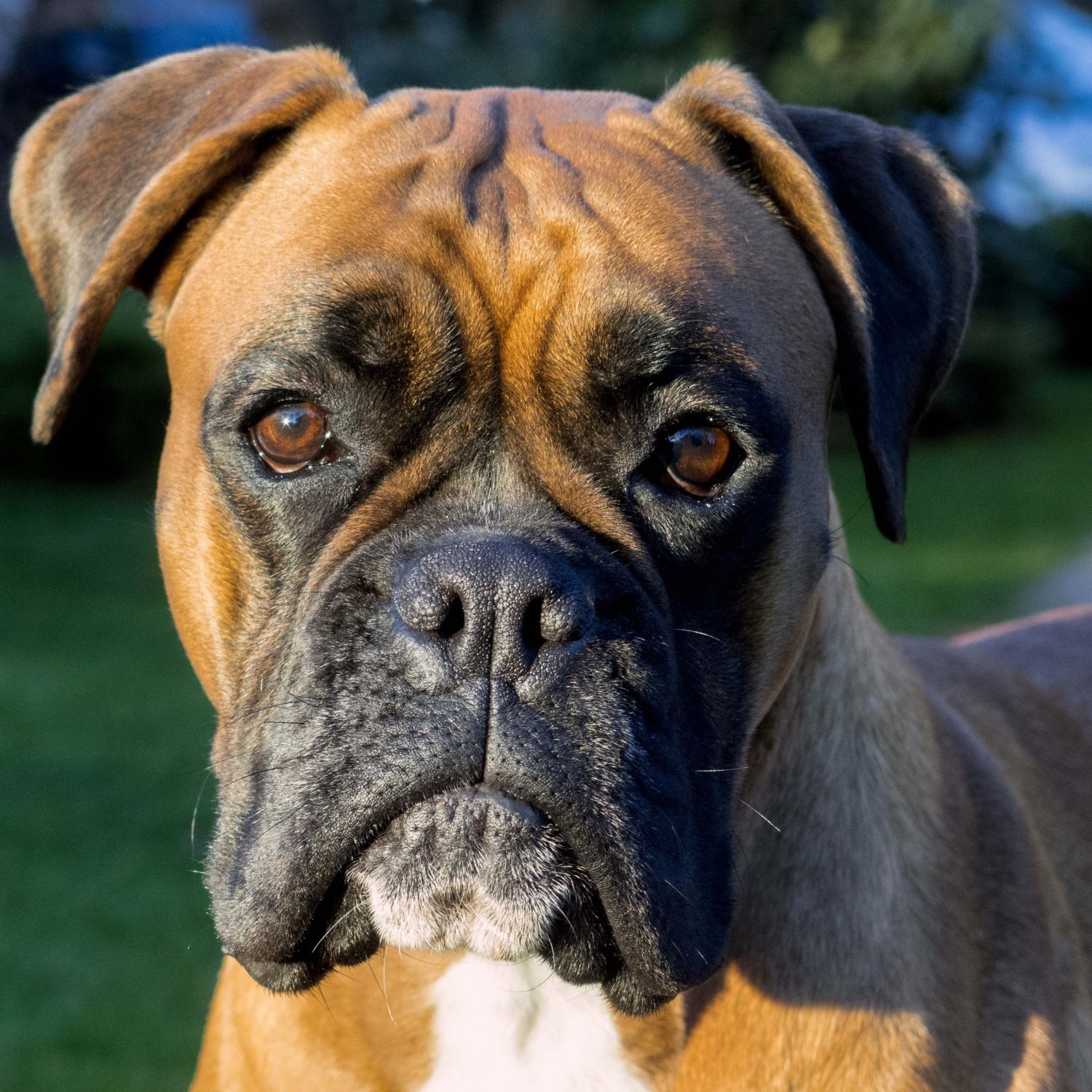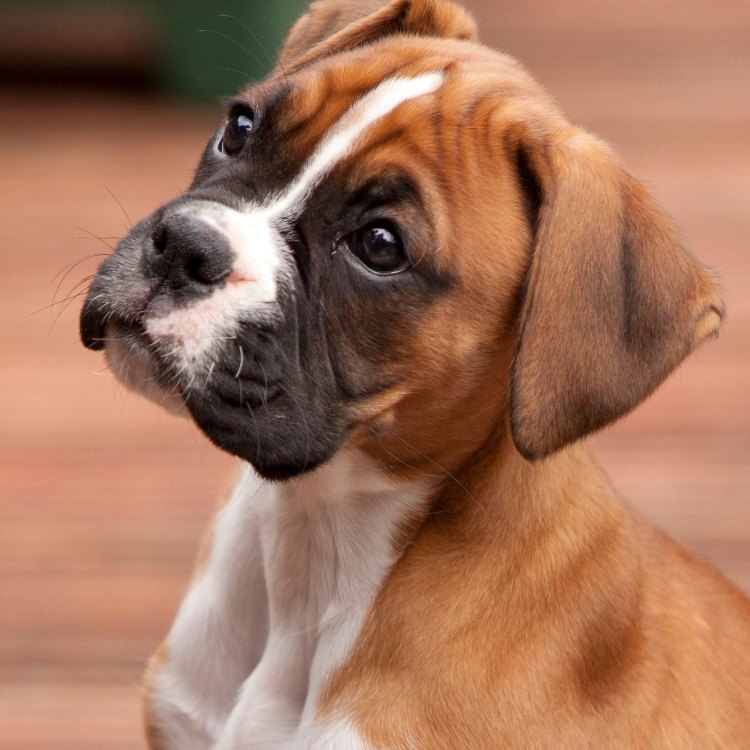
Boxer Dog
20-25 inches (50-63 cm)
Boxer dogs are popular domesticated pets known for their devoted and playful nature. These medium-sized and muscular dogs belong to the Canidae family, and can grow up to 20-25 inches (50-63 cm) in length. Their energetic and friendly personalities make them great companions for families and individuals alike. #BoxerDog #CanidaeFamily #PetLove #DogBreeds
Animal Details Summary:
Common Name: Boxer Dog
Kingdom: Animalia
Habitat: Typically found in human households
The Loyal and Lovable Boxer Dog: A Guide to this Athletic and Affectionate Breed
Imagine walking into your home and being greeted by a wagging tail, excited barks, and a pair of big, brown eyes filled with love and adoration. For many dog lovers, this is a dream come true, and for those who own a Boxer dog, this is simply a part of their everyday lives.Boxers, known for their playful and friendly personalities, have been winning the hearts of dog lovers around the world for centuries. From their athletic build to their fiercely loyal nature, there is no denying that this breed is one of a kind Boxer Dog. In this article, we will dive into the world of the Boxer dog, exploring their history, characteristics, and why they make such great companions.
A Brief History of the Boxer Dog
The Boxer dog, also known as the German Boxer, has a long and fascinating history. It is believed that this breed originated in Germany during the 19th century, with the crossbreeding of the extinct Bullenbeisser and the English Bulldog. Originally, these dogs were used for hunting and as guard dogs, but over time, they became sought after for their loyalty, intelligence, and playful nature.Their name, Boxer, is said to come from their tendency to playfully “box” with their front paws. However, some historians believe that the name actually stems from their physical appearance, with their square-shaped heads and strong jaws resembling a boxer’s fighting stance.
Physical Characteristics
The Boxer dog falls under the Kingdom Animalia, Phylum Chordata, Class Mammalia, Order Carnivora, and Family Canidae. They are a domesticated breed, typically found in human households, and are considered to be medium-sized dogs, with a muscular build. On average, Boxers stand between 20-25 inches (50-63 cm) tall and weigh between 55-70 pounds (25-32 kg) Bearded Dragon.One of the most distinctive features of the Boxer is their body shape, which is square and powerful. They have a broad chest, a deep ribcage, and well-developed muscles, making them agile and athletic. Their coat is short, smooth, and comes in various colors, including fawn, brindle, and white. Their faces have a charming and expressive appearance, with wrinkled foreheads, prominent jowls, and dark, soulful eyes.
Temperament and Personality
If there is one word that can describe the Boxer dog’s personality, it would be “energetic”. These dogs are known for their boundless energy and playful nature. They love to run, jump, and play, making them ideal companions for active families. Their love for exercise also means that they excel in dog sports such as agility, obedience, and tracking.Aside from their athletic abilities, Boxers are also incredibly loyal and affectionate. They form strong bonds with their owners and are always eager to please. With proper socialization and training, they can be great with children and make excellent family pets.
However, it is essential to note that Boxers go through a phase called “the teenage years” where they can become stubborn and headstrong. This is not to say that they are difficult to train, but consistent and patient training is necessary to help them reach their full potential.
Feeding and Care
Boxers are omnivorous, meaning they eat a combination of meat, vegetables, and grains. As with any dog, it is essential to provide them with a balanced and nutritious diet to ensure their well-being. It is recommended to feed them high-quality dog food that is appropriate for their age, size, and activity level. Avoid giving them table scraps, as some human foods can be harmful to dogs.In terms of grooming, Boxers have a low-maintenance coat that only requires occasional brushing and bathing. However, they are prone to allergies, so it is crucial to keep an eye out for any skin issues or irritation. Regular visits to the vet for check-ups and vaccinations are also necessary to keep them healthy and happy.
Geographical Distribution
Boxers are a popular breed worldwide and can be found in many countries, including the United States, Germany, Canada, and the United Kingdom. However, they are believed to have originated in Germany and were first recognized as a breed by the American Kennel Club in 1904.Why You Should Consider a Boxer Dog as a Companion
With their charming personalities and lovable nature, it is no surprise that Boxers are a beloved breed among dog owners. But aside from their endearing qualities, what makes them such great companions?For starters, Boxers are incredibly loyal and make great guard dogs. Their courage and protective nature make them excellent watchdogs, and they will do whatever it takes to protect their family. This trait, along with their boundless energy and athleticism, also makes them great outdoor companions and adventure partners.
Additionally, Boxers are highly intelligent and eager to please, which means they are relatively easy to train. With consistency and positive reinforcement, they can learn basic commands and even more advanced skills. This makes them great for first-time dog owners or those looking for a trainable breed.
Finally, Boxers are known for their goofy and playful nature. They are always ready for a game of fetch or a romp around the backyard, making them great for families with children. They are also social animals and love to be around their human companions, making them great “lap dogs” despite their size.
In Conclusion
In summary, the Boxer dog is a loyal, fun-loving, and energetic breed that has been captivating the hearts of dog lovers for centuries. They make great companions for active individuals and families, and their love and loyalty know no bounds. Whether you are looking for a running buddy, a protector, or simply a lovable companion, the Boxer could be the perfect breed for you.Next time you see a Boxer, take a moment to appreciate their muscular build, charming face, and wagging tail. These magnificent dogs have a rich history and a unique personality that makes them stand out from the rest. As they say, “Once you have a Boxer in your life, you will never want any other breed.”

Boxer Dog
Animal Details Boxer Dog - Scientific Name: Canis familiaris
- Category: Animals B
- Scientific Name: Canis familiaris
- Common Name: Boxer Dog
- Kingdom: Animalia
- Phylum: Chordata
- Class: Mammalia
- Order: Carnivora
- Family: Canidae
- Habitat: Typically found in human households
- Feeding Method: Omnivorous
- Geographical Distribution: Worldwide
- Country of Origin: Germany
- Location: Domesticated
- Animal Coloration: Varies
- Body Shape: Medium-sized and muscular
- Length: 20-25 inches (50-63 cm)

Boxer Dog
- Adult Size: 50-80 pounds (23-36 kg)
- Average Lifespan: 10-12 years
- Reproduction: Sexual
- Reproductive Behavior: Mating
- Sound or Call: Bark
- Migration Pattern: Non-migratory
- Social Groups: Pack
- Behavior: Energetic, playful, and loyal
- Threats: Genetic health problems
- Conservation Status: Not applicable
- Impact on Ecosystem: Not applicable
- Human Use: Companion and working dog
- Distinctive Features: Square-shaped head, strong jaws, and a docked tail
- Interesting Facts: Boxers are known for their expressive faces and clownish personalities. They were originally bred in Germany for bull-baiting and later became popular as guard dogs and family pets. Boxers are intelligent and trainable, making them versatile working dogs. They are also known for their sensitivity and love for their families.
- Predator: No natural predators

Canis familiaris
The Lovable Boxer Dog: From Bull-Baiting to the Perfect Family Companion
When you think of a boxer, what comes to mind? Is it their square-shaped head, strong jaws, or energetic demeanor? Or perhaps it's their expressive faces and clownish personalities that make them such lovable and popular dogs. Whatever it may be, there is no doubt that the Boxer dog is a unique and fascinating breed. Originally bred in Germany for bull-baiting, they have now transitioned into the ideal family companion and have earned a special place in our hearts. In this article, we will explore the distinctive features, interesting facts, and the role of Boxers in our lives PeaceOfAnimals.Com.With an adult size of 50-80 pounds (23-36 kg) and an average lifespan of 10-12 years, the Boxer is considered a medium-sized breed. But what sets them apart from other dogs is their innate athleticism and energy. They are full of life and love to play, making them the perfect playmate for kids. They are also incredibly loyal and protective of their families, making them excellent guard dogs.
But what makes them stand out physically is their square-shaped head, strong jaws, and a docked tail. The Boxer's head is unique in its shape due to the crossbreeding of the German Bullenbeisser (an extinct breed) and the English Bulldog. This results in a broad, powerful head that is proportionate to their body. Their strong jaws not only aid in their original purpose of bull-baiting but also in their current roles as working and protection dogs.
The Boxer's tail is typically docked to a length of 2-3 inches, giving it a balanced and compact look Barbet. While this practice is not as common in some countries today, it is still done for working dogs, and for show dogs competing in certain countries' standards. In addition to their physical features, Boxers are also known for their distinctive coat colors, which can be fawn or brindle, and can also have white markings.
Moving beyond their looks, Boxers are known for their expressive faces and clownish personalities. Their faces can easily convey emotions, making them highly expressive and endearing. They also have a playful and mischievous nature, always finding ways to entertain themselves and their families. It's no wonder they are nicknamed as the "Peter Pan" of dog breeds.
But Boxers weren't always known for their comedic antics. In fact, they were originally bred in Germany in the 19th century for bull-baiting, a cruel sport where dogs would attack and bring down a bull. Thankfully, these practices were outlawed, and Boxers were then used for various roles such as cattle dogs, hunting dogs, and later as guard dogs. Their intelligence and trainability also made them popular as working dogs, particularly in law enforcement and military work.
One of the fascinating aspects of Boxers is their sensitivity. They are deeply emotional and can pick up on their owners' moods and feelings. This quality makes them excellent therapy dogs, providing emotional support to people in need. Their sensitivity also makes them fiercely loyal and devoted to their families, often referred to as "shadows" as they always want to be by their loved ones' side.
In terms of reproductive behavior, Boxers are sexual and mate to reproduce. However, their breeding process is not as straightforward as one may think. Boxers have a unique breeding style called "mating beyond the tie". After the male and female mate, they will remain in a locked position for up to 30 minutes. This prolonged lock increases the chances of successful fertilization and pregnancy.
When it comes to communication, Boxers use their famous bark as their primary sound or call. They also have a variety of vocalizations, including growls, whimpers, and grunts, to express different emotions and needs. This becomes handy during training as they are easily trainable and can quickly learn to communicate with their owners.
Boxers are also social animals and thrive in the company of others. In the wild, they would live in a pack, and this group dynamic is still evident in domesticated Boxers. They are great with other dogs and can quickly form a close bond with their human family. But like any other breed, it's essential to socialize them early on to ensure they feel comfortable and safe around other animals and humans.
As for their migration pattern, Boxers are non-migratory animals. This means that they do not undergo seasonal movements or long-distance travel. They prefer to stay close to their pack and are content with staying in one place.
Fortunately, Boxers do not have any natural predators. Being fierce and athletic dogs, their only threat comes from potential genetic health problems. Boxers are prone to certain conditions such as hip dysplasia, heart problems, and cancer. It's essential to work with reputable breeders and provide proper healthcare and nutrition to ensure their well-being.
Despite their potential health issues, Boxers have always been popular among dog owners. Their loyal and loving nature undoubtedly plays a significant role in this, but let's face it, their cute and expressive faces are impossible to resist. They have been used as companion dogs for many years and are known for being gentle and playful with children, making them an excellent addition to any family.
But Boxers' role in our lives doesn't just end there. They are also versatile working dogs, owing to their intelligence and ability to learn quickly. They excel in tasks such as search and rescue, therapy work, and even as guide dogs for individuals with disabilities. Their adaptable and energetic nature makes them suitable for various tasks, and their sensitive nature allows them to form a deep connection with their owners, making them a reliable and dedicated partner.
From their origins in bull-baiting to their current role as the perfect family companion, Boxers have come a long way. They may not have a specific conservation status or impact on the ecosystem, but their impact on humans' lives is undeniable. They provide love, companionship, and protection, making them an integral part of our families.
In conclusion, the Boxer dog is a unique breed that encompasses various fascinating qualities. From their distinctive physical features and playful personalities to their sensitivity and loyalty, they have earned their spot in our hearts. They may have started as bull-baiters, but they have surely evolved into the perfect family dog. So, next time you come across a Boxer, you'll now have a deeper understanding of why they are the lovable and lovable dogs that they are.

The Loyal and Lovable Boxer Dog: A Guide to this Athletic and Affectionate Breed
Disclaimer: The content provided is for informational purposes only. We cannot guarantee the accuracy of the information on this page 100%. All information provided here may change without prior notice.












